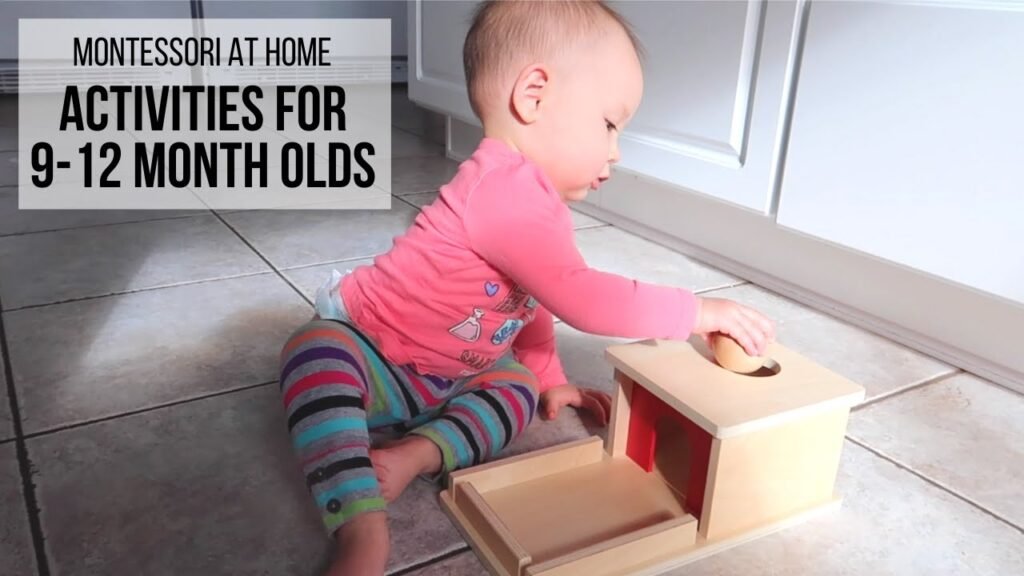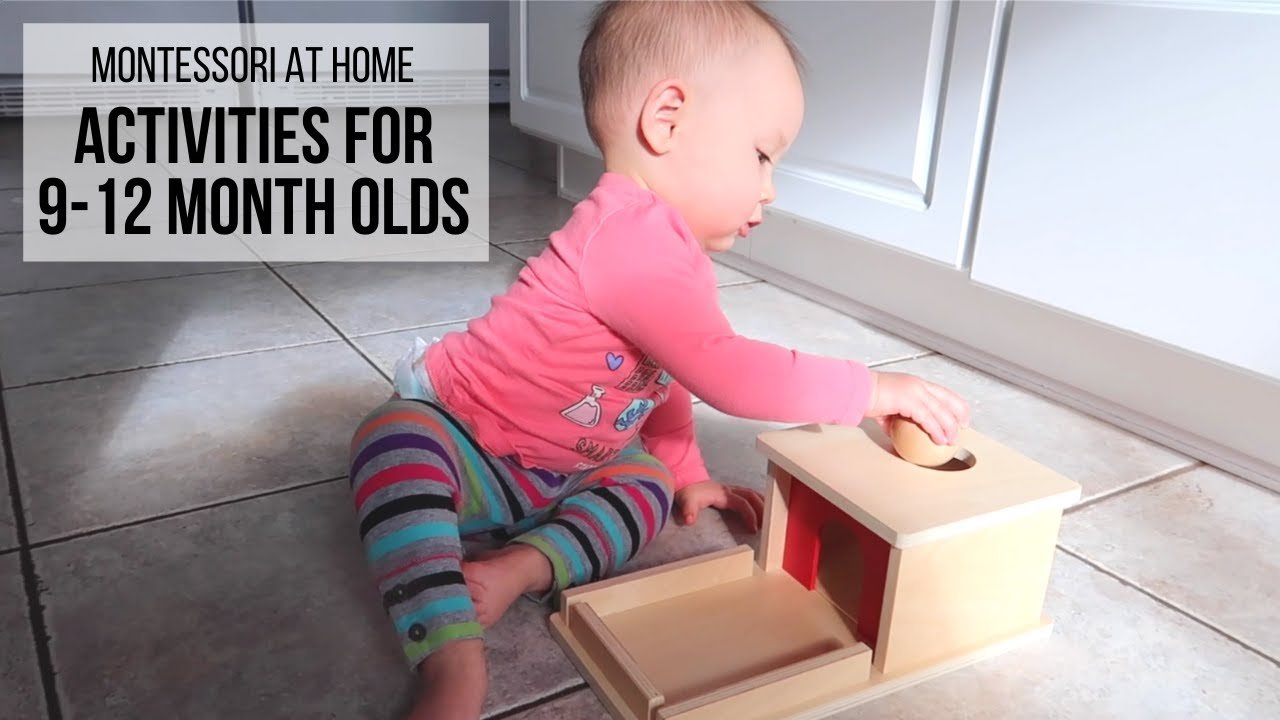Hi there! When it comes to your baby’s development, the period between 9-12 months is crucial. During this time, babies are working on fine motor skills, gross motor development, and language acquisition. Introducing baby sign language at this stage can aid in communication and independence. As a parent of two girls myself, I understand the importance of engaging Montessori activities at home during this stage.
For babies between 9-12 months, activities like object permanence box, ball tracker, and language baskets can help in their overall development. These activities challenge babies to improve their skills and understanding, while also aiding in motor skill development and coordination. As a mom sharing practical tips for busy parents interested in Montessori philosophies at home, I recommend trying out these simple and engaging activities with your little one.

Importance of Introducing Baby Sign Language
Developmental Benefits of Baby Sign Language
When it comes to enhancing communication skills and reducing frustration for babies, the use of baby sign language can be incredibly beneficial. By introducing babies to sign language at an early age, you are providing them with a means to express themselves before they are able to verbally communicate effectively. This can help in fostering a strong parent-child bond and facilitating early communication between you and your little one.
Enhancing Communication Skills
Baby sign language can significantly enhance communication skills for both parents and babies. By teaching babies simple signs for common words and phrases, you are enabling them to convey their needs and desires effectively. This can reduce frustration on both ends by providing a way for babies to express themselves before they can speak.
Reducing Frustration for Babies
Babies often experience frustration when they have trouble expressing themselves or when their needs are not met promptly. Introducing baby sign language can help alleviate this frustration by giving babies the tools to communicate with you effectively. This can lead to a more peaceful and harmonious environment for both you and your baby.
When to Start Introducing Baby Sign Language
Ideal Age Range for Introducing Baby Sign Language
The ideal age range for introducing baby sign language is typically around 9 to 12 months. During this stage of development, babies are starting to explore their independence and are often eager to communicate their needs and desires. By introducing sign language at this age, you can take advantage of babies’ natural curiosity and readiness to learn.
Signs that Baby is Ready to Start Learning Sign Language
Some signs that your baby may be ready to start learning sign language include increased interest in communication, frustration from not being understood, and the ability to mimic simple gestures. If your baby is showing these signs, it may be a good time to start introducing basic signs to facilitate communication.
How to Start Introducing Baby Sign Language
Choosing Basic Signs to Begin With
When starting to introduce baby sign language, it is important to choose basic signs that are relevant to your baby’s daily routine. Signs for common words like “eat,” “drink,” “more,” and “sleep” can be a good starting point. By consistently using these signs in context, your baby will begin to associate them with their meanings and start using them to communicate.
Consistency in Teaching Signs
Consistency is key when teaching baby sign language. Make sure to use the signs consistently in different situations to reinforce their meanings. Repetition and patience are essential in helping babies learn and remember the signs effectively.
Incorporating Signs into Daily Routine
Incorporating signs into your daily routine is a great way to reinforce their meanings and help babies learn them naturally. Use signs during meal times, playtime, and before bedtime to create a language-rich environment that encourages communication through sign language.
Baby Sign Language Activities and Resources
Using Flashcards and Visual Aids
Flashcards and visual aids can be helpful tools in teaching baby sign language. Use colorful flashcards with simple signs and corresponding images to help babies associate the signs with their meanings. Visual aids can make learning more engaging and effective for babies.
Interactive Games for Learning Signs
Engaging babies in interactive games that involve sign language can make learning fun and exciting. Play games that require babies to use signs to communicate, such as “Simon Says” with sign language commands. These games can help reinforce the signs and encourage babies to use them in different contexts.
Online Resources for Baby Sign Language
There are numerous online resources available for learning baby sign language, including websites, apps, and videos. These resources can provide valuable information, tips, and tutorials on how to effectively teach sign language to babies. Utilize these resources to enhance your teaching methods and make learning sign language a positive experience for both you and your baby.
Benefits of Baby Sign Language
Facilitating Early Communication
One of the main benefits of baby sign language is its role in facilitating early communication between parents and babies. By giving babies a way to express themselves through signs, you are laying the foundation for effective communication skills that will help them as they grow and develop.
Strengthening Parent-Child Bond
Introducing baby sign language can strengthen the bond between parents and babies by promoting interactions and understanding. When parents are able to communicate effectively with their babies through signs, it creates a sense of connection and closeness that can have long-lasting benefits.
Boosting Cognitive Development
Baby sign language has been shown to boost cognitive development in babies by stimulating language acquisition and problem-solving skills. By engaging babies in learning signs and using them in different contexts, you are providing them with valuable cognitive challenges that can enhance their overall development.
Common Misconceptions about Baby Sign Language
Sign Language Hindering Verbal Development
One common misconception about baby sign language is that it may hinder babies’ verbal development. However, research has shown that learning sign language can actually enhance babies’ linguistic abilities and lead to earlier verbal communication. Using sign language in conjunction with verbal communication can provide a well-rounded approach to language development.
Difficulty in Teaching Signs to Babies
Another misconception is that teaching sign language to babies can be challenging and time-consuming. While it does require patience and consistency, teaching signs to babies can be a rewarding experience for both parents and babies. With the right resources and methods, introducing baby sign language can be a fun and engaging process.
Success Stories of Baby Sign Language Users
Personal Accounts of Parents
Many parents have shared their success stories of using baby sign language with their babies. From improved communication to reduced frustration, parents have seen the positive impact that sign language can have on their babies’ development. Hearing personal accounts can inspire other parents to give baby sign language a try and experience its benefits firsthand.
Positive Impact on Babies’ Communication Skills
The positive impact of baby sign language on babies’ communication skills is evident in the success stories of many parents. Babies who have learned sign language often demonstrate improved language acquisition, better communication with their parents, and increased confidence in expressing their needs and desires. These success stories highlight the effectiveness of baby sign language in enhancing babies’ overall development.
Challenges in Introducing Baby Sign Language
Time Commitment Required for Teaching Signs
One of the main challenges in introducing baby sign language is the time commitment required for teaching signs to babies. Teaching sign language effectively involves patience, consistency, and repetition, which can be time-consuming for busy parents. However, the long-term benefits of baby sign language often outweigh the initial time investment.
Resistance from Traditionalists
Some parents may face resistance from traditionalists who believe that sign language is unnecessary or may interfere with babies’ verbal development. It is important to educate others about the benefits of baby sign language and the positive impact it can have on babies’ communication skills. By sharing success stories and scientific research, you can help others understand the value of introducing sign language to babies.
Conclusion
Baby sign language is a valuable tool for enhancing communication between parents and babies, especially during the critical developmental stage of 9 to 12 months. By introducing sign language at this age, you can help babies express themselves effectively, reduce frustration, and strengthen the bond between parent and child. The benefits of baby sign language extend beyond communication skills and can have a lasting impact on babies’ cognitive development and linguistic abilities. Consider incorporating sign language into your daily routine to create a language-rich environment that promotes early communication and understanding between you and your baby.

